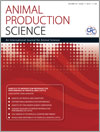
Animal Production Science
Volume 54 Number 1 2014
Genetics to Improve Cow Reproductive Performance in Tropical Beef Cattle
AN13043Genetics of early and lifetime annual reproductive performance in cows of two tropical beef genotypes in northern Australia
Reproduction is a key profit driver in northern beef production and opportunities exist to improve through selection. In total, 22 000 cows of known pedigree and management were recorded for reproduction traits from first mating through to almost 9 years of age and showed early-in-life measures of reproduction had high heritabilities and were genetically related to lifetime reproductive performance. Weaning rates in northern Australia can be improved by utilising the genetic difference that exists in breeds and future reproduction rates can be increased through selection.
AN13016Genomic selection for female reproduction in Australian tropically adapted beef cattle
Poor reproduction of beef cows in northern Australia limits total herd productivity. This study describes how genomic technology was used to derive genomic estimated breeding values for a variety of female reproduction traits. Although these results are only modest, they are sufficiently useful to assist beef breeders to improve their herd reproduction.
AN12421Factors associated with calf mortality in tropically adapted beef breeds managed in extensive Australian production systems
Calf mortality reduces overall productivity and welfare in extensive production systems. This study identified factors associated with increased calf mortality, including location and year, calf attributes including both low and high birthweight, birth type and horn status, along with cow attributes, such as cow breed, age, teat size and previous reproductive history. Opportunities exist to improve calf survival in extensive production environments by managing these factors.
AN12427The genetics of cow growth and body composition at first calving in two tropical beef genotypes
For Australia’s tropically adapted beef cattle, the genetics of growth and body composition in first-calf cows are not well understood. This study aimed to estimate these parameters in Brahman and Tropical Composite females and showed that higher genetic milk was associated with greater loss of body condition during first lactation. Selection based on a multiple-trait genetic evaluation which incorporated these results would, however, allow simultaneous improvement for both.
AN12422Genetic parameters for calf mortality and correlated cow and calf traits in tropically adapted beef breeds managed in extensive Australian production systems
Calf losses are an important issue in northern beef production systems, but the genetic contributions to calf survival are unknown. This study has shown that there are moderately heritable maternal genetic contributions to calf losses through component traits. Selection for maternal birth weight and cow teat and udder characteristics provide opportunities to reduce calf losses.
AN13012Genetic relationships of female reproduction with growth, body composition, maternal weaning weight and tropical adaptation in two tropical beef genotypes
The genetic relationships of female reproduction with growth, body composition, maternal weaning weight and tropical adaptation traits are not well understood in Australia’s tropically adapted beef cattle. This study aimed to estimate these relationships and showed that few genetic antagonisms exit between these. Selection based on a multiple-trait genetic evaluation which incorporated these results could achieve simultaneous improvement for female reproduction, growth and body composition.
AN13044Genetic correlations of young bull reproductive traits and heifer puberty traits with female reproductive performance in two tropical beef genotypes in northern Australia
Reproductive rate can be improved by selection; however, response is often slow in beef cattle because recording occurs later in life in reproductive active females. Records on male reproduction and heifer puberty were used to estimate the genetic relationships with female reproduction traits and results showed several had strong genetic correlations. Opportunity exists to increase rate of genetic progress in female reproduction rates in northern Australia by indirect selection on male and heifer puberty traits.
AN13141Genetic relationships between steer performance and female reproduction and possible impacts on whole herd productivity in two tropical beef genotypes
Genetic relationships of steer growth and carcass traits with female reproduction are not well understood in Australia’s tropically adapted beef cattle. This study showed there are few genetic antagonisms between economically important steer and female traits. Selection based on the results of a multi-trait genetic evaluation will allow simultaneous improvement of these traits, and the few unfavourable genetic associations identified in this study to be managed.
AN13134Multi-trait assessment of early-in-life female, male and genomic measures for use in genetic selection to improve female reproductive performance of Brahman cattle
Reports show there are individual early-in-life female, male and genomic measures that could be used to help genetically lift reproduction rates in Brahman cattle. The most practical of these were examined for use in combination in multi-trait selection and it was shown that the gains that could result were substantial. Genomic information was also best used in combination with other measures.



